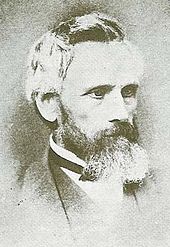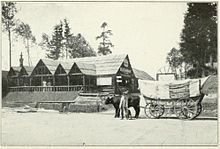Ezra Meeker
He married Eliza Jane Sumner in 1851; the following year the couple, with their newborn son and Ezra's brother, set out for the Oregon Territory, where land could be claimed and settled on.
He obtained work as printer's devil at the Indianapolis Journal, where his duties involved delivering the newspaper to subscribers, among them local pastor Henry Ward Beecher.
Ezra and Eliza Jane Meeker vacillated on the decision, and it was not until early April 1852, more than a month after the birth of their son Marion, that they decided to travel the Oregon Trail.
That group had made it as far as Fort Laramie (today in Wyoming) before losing the last of its menfolk, and the women and children turned back, hoping to regain their homes in the East.
Oliver Meeker brought the livestock ahead overland, and met Ezra and his family on their arrival in Portland on October 1, 1852, where they slept inside a house for the first time since leaving Iowa.
[18] All of the party survived, although Jacob Davenport, one of Oliver Meeker's friends from Indiana, became ill on the final part of the trip and died some weeks after reaching Portland.
By this time, Ezra Meeker and his wife were determined to fulfill their original plan to farm, and when work was abandoned on the wharf, he went to find land which could be cultivated.
They immediately responded that Oliver would return to Indiana by early the following year, and put their plans on hold to prepare for and finance his journey by steamship and rail.
The agreement, signed under duress, restricted the Native Americans to inadequate reservations, and in 1855, the Puget Sound War broke out, bringing unrest to the region over the following two years.
Ezra Meeker had maintained good relations with the Native Americans, and did not fight in the conflict, though he accompanied one expedition to recover possessions captured by the Indians.
He met with newspaper editor Horace Greeley (known for his famous advice, "Go West, young man") and with railroad mogul Jay Cooke as part of his promotional blitz.
[b][40][41] Meeker strove to improve life in the region, and donated land and money towards town buildings and parks, a theatre and a hotel while defraying the start-up costs of a wood products factory.
Restless, forceful, a natural leader, he became a prime mover, galvanizing the citizens of Puyallup into action on such vital problems as the building of streets, roads, homes, schools, and businesses and transforming the forest into one of the most progressive small communities in the state.
He had been an adventurer, laborer, surveyor, longshoreman, farmer, merchant, community leader, civic builder, richest man in the state, world traveler, miner and writer.
[64] Some of Meeker's friends tried to talk him out of the trip; one local minister warned against this "impracticable project", stating that it was "cruel to let this aged man start on this journey only to perish by exposure in the mountains".
[65] Meeker had taken an ox team and wagon to Portland's Lewis and Clark Centennial Exposition in 1905; en route he had kept his eyes open for places to set up suitable monuments on the Cowlitz Trail, on which pioneers had journeyed from the Columbia River to Puget Sound.
"[73] According to reporter Bart Ripp in his 1993 article on Meeker, "the first expedition east in 1906 was supposed to be a speaking tour, but people were more interested in seeing the old coot in a covered wagon.
With the Oregon Trail run completed, he proceeded east through Ohio, Pennsylvania, and New York State, seeking to both raise public awareness and earn some money for himself through sales of his merchandise.
The message was apparently not well-communicated, as at 161st and Amsterdam Avenue a policeman arrested Meeker's helper, Mardon, for driving cattle upon the streets of New York in violation of a local ordinance.
The expedition was offloaded from the train in Portland, and Meeker proceeded north across Washington State (receiving a much warmer reception) on a slow route, finishing in Seattle on July 18, 1908.
He had donated his wagon and oxen to a park in Tacoma: when officials there expressed concern about the cost of building a proper pavilion for them, Meeker reclaimed them and set off with them to California.
Deeming Dandy unfit for the road, Meeker had him slaughtered in Portland in June 1914 and had the hide shipped back to Tacoma for taxidermy; in November, the same fate met Dave in California.
[91] Bernard Sun, whose grandparents were Oregon Trail pioneers in Wyoming, remembered another side of Meeker: He'd camp down on Rush Creek with a covered wagon.
At a stop in Boise, Meeker quipped they were making better time than with his ox team, and in Dayton met aviation pioneer Orville Wright, to whom he commented, "You'd be surprised at the difference between riding in a Prairie Schooner and in an airplane.
[101][103] Wanting the government to build a road over Naches Pass, where he had guided his father's party seventy years before, Meeker ran for the Washington House of Representatives in 1924 from the 47th district but was defeated in the Republican primary by 35 votes.
Beginning in 1925, Meeker pressed for such a half dollar to honor the pioneers and provide money for his efforts, and in April 1926 he appeared before a Senate committee, urging the passage of legislation.
Under a plaque based on the Oregon Trail Memorial coin Ezra Meeker had inspired, their gravestone, erected by the OTMA in 1939, reads, "They came this way to win and hold the West.
[113][114] The commemorative half dollars were struck in small numbers in most years of the 1930s; after collectors complained about the lengthy series and high prices, Congress forbade further strikings in 1939.
"[119] Driggs stated of Meeker after his death: So the Oregon Trail was blazed and tramped—traders, trappers, gold-seekers, missionaries, colonists—until the highway stretched from the Missouri River to the Pacific Ocean.
Then an old man, almost eighty, clambered into a prairie schooner, made in part of some in which the pioneers had journeyed westward, and the Oregon Trail was retraced and marked with monuments, that a people and a nation may not forget.























